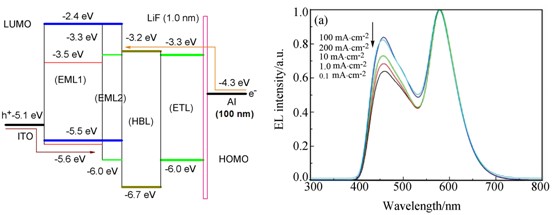[1] Duggal, R.; Shiang, J. J.; Heller, C. M.; Foust, D. F.
Appl. Phys. Lett. 2002,
80, 3470.

[2] Shen, Z.; Burrows, P. E.; Bulović, V.; Forrest, S. R.; Thompson, M. E.
Science 1997,
276, 2009.

[3] Wong, W.-Y.; Ho, C.-L.
Coord. Chem. Rev. 2009,
253, 1709.

[4] Zhou, G. J.; Wang, Q.; Ho, C.-L.; Wong, W.-Y.; Ma, D. G.; Wang, L. X.
Chem. Commun. 2009, 3574.

[5] Wang, Q.; Ding, J.; Ma, D.; Cheng, Y.; Wang, L.; Jing, X.; Wang, F.
Adv. Funct. Mater. 2009,
19, 84.
[6] Ho, C.-L.; Lin, M.-F.; Wong, W.-Y.; Wong, W.-K.; Chen, C. H.
Appl. Phys. Lett. 2008,
92, 083301.

[7] Ho, C.-L.; Wong, W.-Y.; Wang, Q.; Ma, D. G.; Wang, L. X.; Lin, Z. Y.
Adv. Funct. Mater. 2008,
18, 928.

[8] Wang, Q.; Ho, C.-L.; Zhao, Y. B.; Ma, D. G.; Wong, W.-Y.; Wang, L. X.
Org. Electron.
2010,
11, 238.

[9] Xie, Z.; Xie, W.; Li, F.; Liu, L.; Wang, H.; Ma, Y.
J. Phys. Chem. C 2008,
112, 9066.

[10] Lee, M. T.; Chen, H. H.; Liao, C. H.; Tsai, C. H.; Chen, C. H.
Appl. Phys. Lett. 2004,
85, 3301.

[11] Tao, S. L.; Zhou, Y. C.; Lee, C.-S.; Lee, S.-T.; Huang, D.; Zhang, X. H.
J. Phys. Chem. C 2008,
112, 14603.

[12] Gebeyehu, D.; Walzer, K.; He, G.; Pfeiffer, M.; Leo, K.; Brandt, J.; Gerhard, A.; Stöβel, P.; Vestweber, H.
Synth. Met.
2005,
148, 205.

[13] Lee, J.; Lee, J.-I.; Song, K.-I.; Lee, S. J.; Chu, H. Y.
Appl. Phys. Lett. 2008,
92, 203305.

[14] He, F.; Tian, L. L.; Xie, W. J.; Li, M.; Gao, Q.; Hanif, M.; Zhang, Y. F.; Cheng, G.; Yang, B.; Ma, Y. G.; Liu, S. Y.; Shen, J. C.
J. Phys. Chem. C 2008,
112, 12024.
[15] Tong, Q.-X.; Lai, S.-L.; Chan, M.-Y.; Zhou, Y.-C.; Kwong, H.-L.; Lee, C.-S.; Lee, S.-T.
Chem. Mater. 2008,
20, 6310.

[16] Baldo, M. A.; Adachi, C.; Forrest, S. R.
Phys. Rev. B 2000,
62, 10967.

[17] He, G. F.; Pfeiffer, M.; Leo, K.; Hofmann, M.; Birnstock, J.; Pudzich, R.; Salbeck, J.
Appl. Phys. Lett. 2004,
85, 3911.

[18] Zhou, L.; Tang, J. K.; Guo, Z. Y.; Feng, J.; Li, X. N.; Li, X. Y.; Deng, R. P.; Zhang, H. J.
J. Lumin. 2010,
130, 2265.

[19] Zhou, L.; Li, X. N.; Li, X. Y.; Feng, J.; Song, S. Y.; Zhang, H. J.
J. Phys. Chem. C 2010,
114, 21723.

[20] Baldo, M. A.; Forrest, S. R.
Phys. Rev. B 2000,
62, 10958.

[21] Baldo, M. A.; Adachi, C.; Forrest, S. R.
Phys. Rev. B 2000,
62, 10967.

[22] Adachi, C.; Baldo, M. A.; Forrest, S. R.
J. Appl. Phys. 2000,
87, 8049.

[23] Qin, D. S.; Li, D. C.; Wang, Y.; Zhang, J. D.; Xie, Z. Y.; Wang, G.; Wang, L. X.; Yan, D. H.
Appl. Phys. Lett. 2001,
78, 437.

[24] Yang, S. H.; Liu, M. H.; Su, Y. K.
J. Appl. Phys. 2006,
100, 083111.

[25] Zhou, L.; Zhang, H. J.; Deng, R. P.; Guo, Z. Y.; Feng, J.; Li, Z. F.
J. Phys. Chem. C 2008,
112, 15065.Kalinowski, J.; Palilis, L. C.; Kim, W. H.; Kafafi, Z. H.
J. Appl. Phys. 2003,
94, 7764.



























